Among the Refuge System’s Guiding Principles – the core values that are ever relevant – is a key concept: “We are land stewards, guided by the teachings of Aldo Leopold that land is a community of life and that love of land is an extension of ethics. We seek to instill the land ethic in our communities.”
Environmental education is fundamental to nurturing a strong land ethic.
So, is the Refuge System doing enough?
We have some outstanding environmental education offerings. Take the Prairie Wetland Learning Center in Fergus Falls, MN, where about 200 fourth and fifth-graders each semester go to the center’s classrooms for two hours a day, five days a week. Students use the outdoor world to learn about nature as well as reading, writing, science and mathematics. It’s a great program. There are just a couple of problems: the Refuge System doesn’t have enough programs of similar caliber; and to create them requires highly trained staff and strong commitment from local school districts to participate.
Most national wildlife refuges do welcome local schoolchildren. But what the youngsters receive when they get to a refuge isn’t always at the same level. Does that matter?
As we look at environmental education in the vision process, should we mandate the development of a standardized toolkit for teachers? Is that a priority? Or should we make a priority the development of environmental education standards? Certainly, the Refuge System should know what it offers and where. So, even as we inventory our wildlife resources, should we also inventory our environmental education programs?
How do we make sure that environmental education does not end with formal schooling? How do we help people know the Refuge System itself — its mission and its breadth? How do we make the U.S. Fish and Wildlife Service open to innovative ways to connect people to America’s great outdoors?
Question abound. For now, the vision process is the most straightforward way of providing answers collectively.
One thing we can all agree on: The public must see the implementation of core values in the Refuge System’s land management and visitor opportunities. Leading by example has the power to change personal behavior. I think the Refuge System, in its execution of core values, is a leader par excellence.




2 Comments in this post »
RSS feed for comments on this post. | TrackBack URL
My husband and I have volunteered at various wildlife refuges in various visitor services roles. I am particularly interested in environmental education and try to get involved in environmental education opportunities whenever possible. I have observed school visits on National Wildlife Refuges that range from a free day out of school with no learning objectives to well developed interactive learning experiences with specific environmental education objectives. Obviously, well-developed programs developed by professional educators are extremely valuable and necessary to nurturing strong land ethic. That is most evident by students’ comments after such programs. For example:
“That was the best walk I’ve ever been on.”
“This is my favorite place in the world.”
“I want to bring my family here.”
“Wow. I love that bird.”
A solid environmental education program requires close collaboration and communication between schools systems and National Wildlife Refuge staff. It also requires input, training and monitoring by education professionals. Ideally, each refuge should have a staff member responsible solely for environmental education, rather than environmental education as an add-on to many other responsibilities. Education is not just information. Professional education training in program research, development and presentation should be provided for any staff member responsible for environmental education. A standardized “backbone” for an environmental education program for every refuge would be a strong asset.
In the words of Richard Louv:
“Healing the broken bond between our young and nature—is in our self-interest, not only because aesthetics or justice demands it, but also because our mental, physical, and spiritual health depends upon it. The health of the earth is at stake as well.”
Structured education on Wildlife Refuges is important but sometimes one of the best things we can do for a child is tell them to go find something to do – in other words go explore the world, the Refuge the neighborhood and create your questions. This can be an integral part of our partnerships with educational institutions. Find the things that interest the kids and spark their imaginations – but continue to work with educators to tie our message into existing curriculums. Teaching basic skills in the three R’s using the natural world is not a stretch. I am basically agreeing with Greg’s original post and your response – just adding my two cents.
OBTW – Thanks for volunteering – the hours donated to Refuges for education and other things is a huge part of our success!